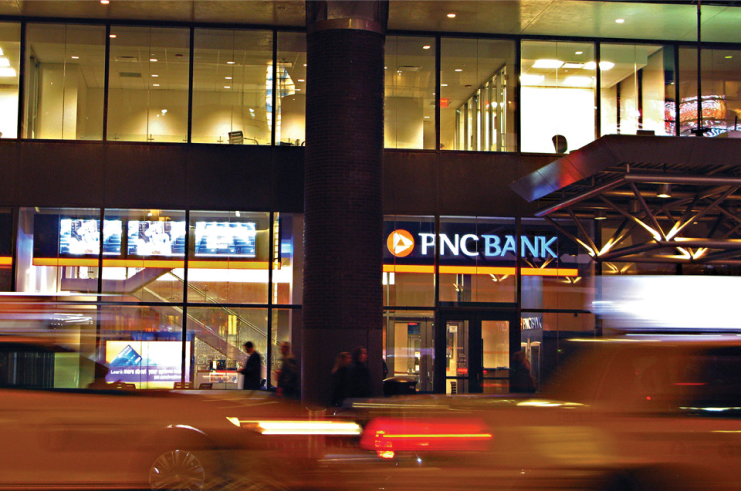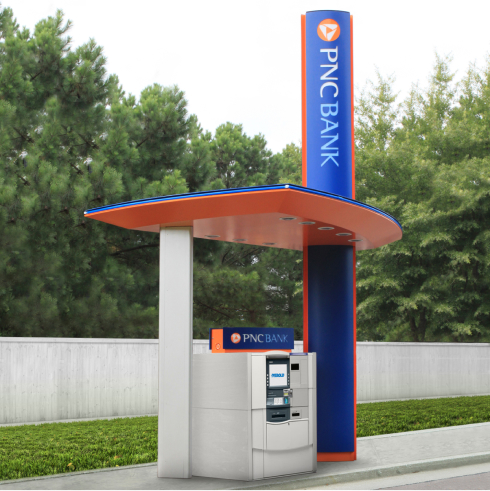
PNC
The banking behemoth builds national presence following its National City acquisition.
Aspiring to uninterrupted growth
PNC Financial Group took a big step forward by bringing National City Corporation into its family. But with the addition came an equally large task: converting more than 26,000 signs across 1,640 branches and facilities and 1,525 ATMs across nine states.
John Zurinskas, Vice President and Group Regional Manager with PNC, had managed plenty of conversions, including one with 320 buildings. But to take on a project of this size without interrupting the customer experience, he elected to partner with Monigle. “I didn’t need that kind of horsepower to do the conversions we had been doing,” he said. “But when we came across National City’s acquisition, I knew I had to bring in a larger firm to help coordinate this thing.”

The right tools and the right partner
Collaboration is vital to any project’s success. We helped PNC create a timeline—managed on SignChart®, Monigle’s proprietary project management software—which kept Zurinskas’ team accountable for meeting necessary deadlines. From coordinating sign-off from individual Retail Market Managers for final design approvals to managing complex variance processes in order to ensure signage approvals aligned with PNC’s schedule and brand, PNC and Monigle worked hand in hand to elevate the PNC brand not only at individual locations but at the organizational level.
Successful large-scale conversion projects also require a high level of strategy. While a rebrand rollout of this magnitude is a lot to tackle on its own, factor in environmental hurdles like winter weather and tornado touchdowns, and the task gains another layer of complexity. To account for Mother Nature, PNC took a phased approach to the rollout, implementing it in four waves—with about 400 sites per wave—over 76 weeks.




"When we came across National City’s acquisition, I knew I had to bring in a larger firm to help coordinate this thing."
Good for the environment (and the bottom line)
In the end, PNC saved more than $8 million with the help of Monigle’s value engineering and competitive bidding process. The bank continues to realize further cost savings with new LED-illuminated signs. Energy consumption has decreased 62 percent on average for all channel letter signs, while display integrity and maintenance expectations have improved.
Since the National City acquisition, PNC has continued to prioritize energy efficiency. It used LED modules in converted channel letter signs following the Royal Bank of Canada (RBC) acquisition as well as in new-build projects (classified as business-as-usual or BAU), most of which are LEED-certified.







Energy consumption has decreased 62 percent on average for all channel letter signs, while display integrity and maintenance expectations have improved.

Continual consideration, sustained success
Another aspect of BAU work is to ensure legacy sites receive attention; PNC works with regional managers to identify signs that are older or damaged or where visibility could improve. And across all sites, there’s a four-hour emergency response time to secure sites that have endured sign damage due to issues like car accidents or severe weather. The PNC Signage Manager System, an online tool that provides information, guidelines and policies, ensures the brand identity is delivered in a memorable and cost-effective manner across locations.
Financially and environmentally, PNC’s conversion and BAU programs have created outcomes that benefit the organization from both a business and brand perspective.

97% of branches
Through the National City, RBC and BAU programs, PNC’s work with Monigle extends to 2,506 of 2,571 branches.
26,000 signs
Following the National City acquisition, PNC converted signs across 1,640 branches and 1,525 ATMs.
50,000 employees
PNC’s workforce is spread across 19 states and the District of Columbia.
$8 million saved
PNC realized a 16.5 percent savings compared to previous conversion projects with the help of Monigle’s value engineering and competitive bidding process.



